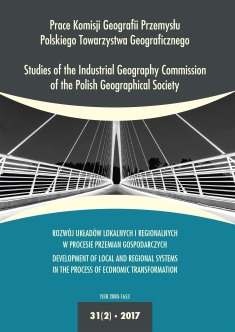Transformation of Commercial and Services Functions of the Centre of a Large Housing District Based on the Example of Nowa Huta in Krakow
DOI:
https://doi.org/10.24917/20801653.312.7Keywords:
city centre, district centre, Krakow, Nowa HutaAbstract
Nowa Huta, which was founded in 1949 as a separate town, after 2 years was incorporated to Krakow, becoming one of its districts. In the very beginning, as intended by the planners, the centre of Nowa Huta was created around Plac Centralny. Alongside the centre of Cracow, it is the most recognizable centre (district centre) of the city. In the socialist period Nowa Huta, being a component of Cracow, gave its residents the feeling of autonomy, mainly due to the role of a nearby steelworks which played an important part in meeting their needs. In the period of the social-economic transformation the role of the factory was significantly reduced. The district fell into an economic and social crisis. At the same time, spatial and social integration of the district with the rest of the city became stronger. It was observed that Nowa Huta, particularly in its central part, was experiencing a crisis of local commercial and service functions. Previously unique functions of the centre started to devaluate. In spite of the onset of revitalization of the place we are observing a systematic disappearance of the central functions of the area, although, it functions as the centre of Nowa Huta in terms of urban layout and in the awereness of the inhabitants and other users. Discussed phenomena of the declining functions of this part of the district should be of great priority for policy makers undertaking the issues related to the development of the city.
Downloads
Metrics
References
Berry, B. (1960). The Impact of Expanding Metropolitan Communities upon the Central Place Hierarchy. Annals of Associations of American Geographers, 13, 147–164.
Bieroń, W. (1957). Huta im. Lenina i Nowa Huta, przewodnik z planem miasta. Kraków-Nowa Huta: Huta im. Lenina z inicjatywy Koła Przewodników PTTK.
Binek, T. (2009). Służby inwestycyjne Nowej Huty. Kraków: Wydawnictwo Towarzystwa Słowaków w Polsce.
Brzosko-Sermak, A., Płaziak, M., Węcławowicz, G. (2011) (2016, 10 stycznia). Market research report from Nowa Huta district in Kraków (Poland). Warszawa: Instytut Geografii i Przestrzennego Zagospodarowania Polskiej Akademii Nauk. Pozyskano z http:// www.renewtown.eu/tl_files/renewtown/internal/WP3_market%20research%20reports_ 11.05.2012/LP_ReNewTown_MRR_NowaHuta_Poland.pdf
Chmielewski, J.M., Węcławowicz, G., Degórska, B., Bartoszczuk, W., Brzosko-Sermak, A. (2013).
Kraków. Wyzwania rozwojowe polityki przestrzennej miasta a studium uwarunkowań i kierunków zagospodarowania przestrzennego na przykładzie Krakowa. Warszawa: Politechnika Warszawska.
Dzieszyński, R., Franczyk, J.L. (2006). Encyklopedia Nowej Huty, Kraków: Wydawnictwo Towarzystwa Słowaków w Polsce, współpraca: „Głos – Tygodnik Nowohucki”, Nowohuckie Centrum Kultury.
Górka, Z. (2005). Nowa Huta – nowa fizjonomia, nowe funkcje i nowa symbolika dzielnicy. W: Z. Górka, J. Więcław-Michniewska (red.). Badania i podróże naukowe krakowskich geografów, t. II. Kraków: Polskie Towarzystwo Geograficzne, 56–63.
Kraków w liczbach 2015 (2016). Kraków: Urząd Miasta Krakowa.
Lokalny program rewitalizacji „starej” Nowej Huty (2008). Kraków: Urząd Miasta Krakowa.
Maik, W. (1997). Podstawy geografii miast. Toruń: Uniwersytet Mikołaja Kopernika.
Maliszowa, B. (1974). Śródmieście. Wybrane zagadnienia planowania. Warszawa: Arkady.
Mydel, R. (1991). Rozmiary i dzienny rytm ruchu pieszego w Rynku Głównym miasta Krakowa. Folia Geographica. Series Geographica-Oeconomica, 27, 13–29.
Mydel, R. (1994). Rozwój urbanistyczny miasta Krakowa po drugiej wojnie światowej. Kraków: Wydawnictwo i Drukarnia Secesja.
Nowakowski, M. (1990). Centrum miasta. Teoria, projekty, realizacje. Warszawa: Arkady.
Płaziak, M. (2014). Przemiany funkcji handlowo-usługowych w mieście postsocjalistycznym na przykładzie Nowej Huty. W: E. Kaczmarska, P. Raźniak (red.). Społeczno-ekonomiczne i przestrzenne przemiany struktur regionalnych, t. 1. Kraków: Oficyna Wydawnicza AFM, 85–98.
Płaziak, M., Szymańska, A.I. (2014). Rola placów targowych w strukturze przestrzenno-społecznej i ekonomicznej Nowej Huty. W: E. Kaczmarska, P. Raźniak (red.). Społeczno-ekonomiczne i przestrzenne przemiany struktur regionalnych, t. 2. Kraków: Oficyna Wydawnicza AFM, 89–105.
Płaziak, M., Szymańska, A.I. (2015). Uwarunkowania działalności przedsiębiorców i rolników na placach targowych na przykładzie Nowej Huty. Przedsiębiorczość – Edukacja, 11, 203–217.
Płaziak, M., Szymańska, A.I. (2016a). Uwarunkowania rozwoju handlu i usług na przykładzie Krakowa – Nowej Huty. W: M. Kosała, M. Urbaniec, A. Żur (red.). Współczesne dylematy badań nad przedsiębiorczością. Kraków: Uniwersytet Ekonomiczny w Krakowie, 231–246.
Płaziak, M., Szymańska, A.I. (2016b). Czynniki warunkujące atrakcyjność dokonywania zakupów na placach targowych Krakowa. Przedsiębiorczość – Edukacja, 12, 217–232.
Płaziak, M., Szymańska, A.I. (2016c). Uwarunkowania zachowań konsumentów na placach targowych na przykładzie Nowej Huty. Studia Ekonomiczne. Zeszyty Naukowe Uniwersytetu Ekonomicznego w Katowicach, 255, 186–199.
Raport końcowy ze spotkań konsultacyjnych dotyczących zmian w przestrzeni Placu Centralnego i Alei Róż (przygotowany na zlecenie Wydziału Strategii i Rozwoju Urzędu Miasta Krakowa) (2009) (2017, 6 stycznia). Pozyskano z http://rewitalizacja.krakow.pl/get_pdf.php?dok_ id=7359
Raźniak, P., Brzosko-Sermak, A. (2014). Zmiany warunków mieszkaniowych w regionie miejskim Krakowa. W: E. Kaczmarska, P. Raźniak (red.). Społeczno-ekonomiczne i przestrzenne przemiany struktur regionalnych, t. 1. Kraków: Oficyna Wydawnicza AFM.
Regulski, J. (1982). Ekonomika miasta. Warszawa: Państwowe Wydawnictwo Ekonomiczne.
Salwiński, J., Sibila, L.J. (red.) (2008). Nowa Huta – przeszłość i wizja. Studium muzeum rozproszonego. Kraków: Muzeum Historyczne Miasta Krakowa.
Wallis, A. (1979). Informacja i gwar – o miejskim centrum. Warszawa: Państwowy Instytut Wydawniczy.
Zborowski, A. (2005). Przemiany struktury społeczno-przestrzennej regionu miejskiego w okresie realnego socjalizmu i transformacji ustrojowej (na przykładzie Krakowa). Kraków: Instytut Geografii i Gospodarki Przestrzennej Uniwersytetu Jagiellońskiego.
Downloads
Published
How to Cite
Issue
Section
License
Articles are published under the terms of the Creative Commons License (CC BY-ND 4.0; Attribution– NoDerivs).

